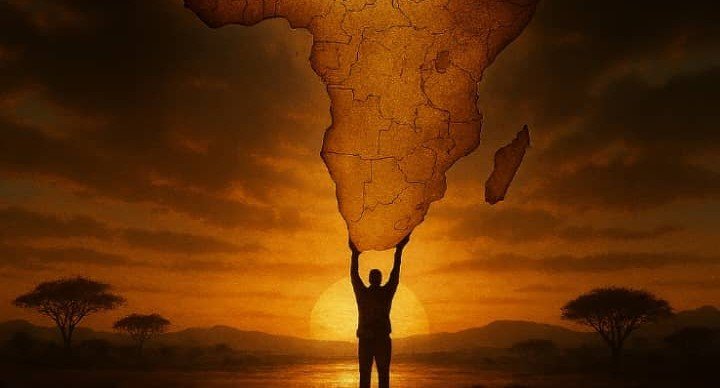Chapter 2
“The rope that ties a goat is also the rope that strangles it.” — Acholi Proverb
By Emmanuel Mihiingo Kaija
Dedication:
To the ancestors who watched their lands carved by foreign hands, and to the generations of Africans who continue to walk, resist, and reclaim their sacred geography.
1.Inheritance of Colonial Boundaries
The moment African nations emerged from the long shadow of colonialism, waving flags of independence and proclaiming sovereignty, they inherited a freedom that was already constrained, for the continent had not been allowed to determine the very lines that now defined its states, the boundaries imposed by European powers without consultation, foresight, or regard for the intricate human, cultural, and ecological landscapes they dissected; these borders, drawn with a mixture of imperial arrogance and administrative convenience during the Berlin Conference of 1884–85 and subsequent colonial treaties, ignored centuries of trade networks, migratory paths, spiritual territories, and kinship systems that had long structured African life, arbitrarily stitching together rival ethnicities and separating communities with shared histories, rituals, and economies. In Somalia, for example, the vision of a “Greater Somalia” was immediately compromised, as the people were divided among Italian Somaliland, British Somaliland, French Djibouti, Ethiopia, and Kenya, leaving clans and communities politically fragmented and culturally constrained, with allegiances drawn across imposed lines rather than lived realities; similarly, the Ewe people of West Africa found themselves split between Ghana and Togo, a separation that disrupted not only trade and governance but familial and spiritual networks that had existed for generations, while in the Great Lakes, Hutu and Tutsi populations were arbitrarily allocated to Rwanda, Burundi, and the Democratic Republic of Congo, a partitioning that would later fuel recurring violence and genocide, showing how lines on a map could dictate life, death, and social cohesion decades into the future. Beyond these headline examples, the effects of these boundaries were felt in the daily lives of Africans across the Sahel, where pastoralists like the Fulani and Tuareg, who had for centuries moved freely across territories following seasonal grazing routes, suddenly became subject to criminalization, militarized policing, and violent disputes simply for crossing a line that had no meaning in their lived geography, creating recurring conflicts that continue to destabilize states and communities. Political elites, aware of the dangers of reopening discussions about these borders, largely acquiesced, fearing that negotiation would unleash disputes, claims, and secessionist movements that might topple fragile states before they could consolidate, yet this very acquiescence planted the seeds for prolonged instability, embedding the paradox that African sovereignty was simultaneously real and illusory, empowering states to govern while denying the people the ability to shape the territories they inhabited, forcing generations to navigate identities, citizenship, and survival within maps drawn for exploitation rather than governance. The inherited boundaries thus imposed a structural tension at the heart of postcolonial Africa: a continent free in name yet constrained by lines of alien design, where political legitimacy rested on a cartography that failed to reflect
On human reality, and yet where communities, families, and networks endured, adapted, and resisted, maintaining connections that defied the rigidity of imposed borders, asserting the resilience of human geography over imperial geometry. A Somali proverb echoes this struggle vividly: “Nin aan talin jirin talo ma taqaan” — “He who never used to decide knows not how to decide,” a reminder that Africa was thrust into decisions about a world it had not designed, forced to inhabit spaces not of its choosing, yet compelled to create life, society, and continuity within them, a tension that would ripple across decades of governance, conflict, and human striving.
2.The OAU 1964 Resolution
As the dust of colonial rule settled over Africa and the first flags of independence fluttered in the capitals of newly sovereign states, the continent faced a challenge both legal and existential: what should be done about the borders inherited from foreign powers, boundaries drawn with compasses, ink, and treaties in European capitals, without consultation with the populations who would live within them, without understanding of centuries-old migratory routes, trade networks, ethnic territories, or linguistic communities? The Organization of African Unity, formed in 1963 as a bulwark of continental solidarity and a defender of independence from neocolonial encroachment, confronted this dilemma with urgency, knowing that any failure to address it could provoke widespread instability, yet also aware that revising borders risked triggering the very chaos it sought to prevent. In 1964, the OAU adopted the principle of uti possidetis juris, codifying colonial boundaries as the legal and recognized borders of postcolonial Africa, a doctrine asserting that whatever territorial possession existed at the moment of independence would define the limits of sovereignty, and that any attempt to challenge these lines could be construed as a threat to peace and legitimate statehood. This legal decision was deeply pragmatic: the continent’s leaders understood that reopening negotiations over boundaries could ignite cascading claims from ethnic groups and communities divided across multiple states for decades, that weak institutional capacity in many countries could be overwhelmed by competing secessionist movements, and that external powers might exploit disputes to destabilize the fragile political order, yet this pragmatism carried with it profound costs. By freezing the lines of colonial demarcation, the OAU enshrined the artificial geometries of empire, cementing divisions that bore little relation to historical, cultural, or economic realities and institutionalizing a political map that often alienated citizens from the states in which they lived. Kwame Nkrumah, the Ghanaian pan-Africanist, had urged that Africa must unite or perish, envisioning a continent in which political, economic, and social solidarity transcended arbitrary colonial divisions, yet his calls for supra-national cohesion were tempered by the imperatives of immediate survival, and the continent opted for a path that privileged legal stability over idealistic unity. The consequences of this decision rippled outward in every direction: civil wars, secessionist movements, ethnic rebellions, and refugee crises became recurring motifs of African life, while borders, elevated to instruments of international law, operated simultaneously as shields for fledgling states and chains constraining the possibilities for historical justice, cultural cohesion, and regional integration. Populations that had once moved fluidly across the Sahel, the Great Lakes, and the Horn of Africa suddenly found their mobility criminalized, pastoralists and traders became vulnerable to state enforcement and cross-border militarization, and centuries-old human networks were forced to contend with arbitrary legal lines whose authority was imposed rather than earned. The paradox was stark: borders that were meant to preserve peace and sovereignty often incubated tension, sowed conflict, and limited the capacity of the continent to pursue integrated development and political solidarity. The Luba proverb encapsulates this duality: “The rope that ties a goat is also the rope that strangles it,” for the OAU’s resolution, while preventing immediate bloodshed, perpetuated a structure of division that continues to shape governance, migration, and conflict across Africa more than half a century later, demonstrating how pragmatism, when imposed upon a complex human geography, can preserve order while simultaneously cementing injustice, legal certainty while perpetuating social fragility, and immediate stability while entrenching the long-term chains of historical and political constraint. Every subsequent war, every refugee movement, every border dispute echoes the tension of that moment in 1964, when the continent chose the map it had inherited over the map it might have designed, and in doing so, accepted both the protection and the suffocation that would define its postcolonial existence.
3.Case Studies of Border as Chain
The inherited colonial borders of Africa, once abstract lines on maps drawn by distant powers, have repeatedly revealed themselves not merely as administrative tools but as active agents shaping the trajectory of conflict, displacement, and social fragmentation, and nowhere is this more evident than in the tragic and intertwined histories of the Biafra war in Nigeria, the protracted Western Sahara dispute, and the refugee crises of the Great Lakes region, each illustrating how the geometry of empire became a chain constraining life, identity, and sovereignty. In Nigeria, the Biafra war of 1967–1970 emerged directly from the tensions embedded in British colonial demarcation, which had deliberately grouped together over 250 ethnic and linguistic communities under a single federal structure while ignoring historical rivalries, cultural differences, and political inequalities, and when the Igbo-dominated southeastern region declared independence as the Republic of Biafra, the Nigerian government invoked the sanctity of inherited borders to justify a military response that quickly escalated into a full-scale war. Over the course of three years, more than one million people perished, the majority from famine and disease exacerbated by blockade, and entire communities were displaced, their human suffering shaped as much by political geography as by military strategy, demonstrating how a line on a map could become a death sentence, a barrier to life, and a generator of historical trauma that reverberates across generations. Thousands of miles to the northwest, the Western Sahara dispute illustrates a different but equally persistent consequence of colonial demarcation: after Spain’s withdrawal in 1975, Morocco annexed the territory, leaving the Sahrawi people stateless in their own land, many confined to refugee camps in Algeria for decades, their identity and claim to self-determination constrained by borders that were originally drawn to serve imperial convenience rather than the will of local populations. The Sahrawi example highlights the enduring entanglement of legality and injustice, as international law recognizes Morocco’s de facto control while the people themselves remain displaced, illustrating the profound dissonance between political authority imposed by inherited borders and the human need for belonging, agency, and sovereignty. Further east, in the Great Lakes region, the 1994 Rwandan genocide produced a humanitarian catastrophe of staggering scale, as millions of Hutu and Tutsi survivors crossed borders into neighboring countries — Zaire (now the Democratic Republic of Congo), Tanzania, and Burundi — creating refugee camps that quickly became militarized zones and destabilizing entire regions, ultimately igniting what would be called the “African World War” from 1998 to 2003, involving seven nations and claiming an estimated 5.4 million lives, most from hunger, disease, and displacement rather than direct combat. In these instances, the borders themselves did not merely passively divide but actively shaped the patterns of human suffering: they determined routes of escape, zones of humanitarian intervention, and fields of militarized contestation, transforming the abstract legacy of empire into tangible chains that constrained survival, mobility, and security. Beyond these headline crises, the everyday reality of African borders continues to create friction: pastoralists such as the Fulani in West Africa, Somali clans in the Horn, and Luo communities in East Africa navigate multiple states, often criminalized for traditional patterns of migration that predate the modern nation-state, leading to localized violence, militarized policing, and recurrent clashes that demonstrate the dissonance between inherited territoriality and lived geography. Collectively, these cases reveal that borders are neither neutral nor purely legalistic; they are active forces that shape identity, limit sovereignty, dictate movement, and, in many instances, become the very instruments of suffering they were meant to prevent. The Shona proverb “Chara chimwe hachitswanyi inda” — “One finger cannot crush lice” — resonates here, as it encapsulates the ripple effect of a single colonial decision: the drawing of a line that seems minor on a map can produce decades of violence, displacement, and intergenerational trauma across multiple communities and nations. Borders, in this sense, are simultaneously shields and shackles, containing immediate chaos while imposing long-term suffering, and the case studies of Biafra, Western Sahara, and the Great Lakes demonstrate how Africa’s inherited cartography has become a structural feature of both vulnerability and resilience, a paradox in which legal stability, state sovereignty, and human tragedy are inseparably intertwined, and where the chains of empire continue to define the contours of human life, political legitimacy, and the possibility of unity more than half a century after independence.
4.Statistics & Evidence
The empirical record of Africa’s post-independence history confirms, in stark and often unsettling detail, that the inherited borders which were codified by colonial powers and enshrined by the OAU’s 1964 resolution have not been neutral instruments of order but active determinants of conflict, displacement, and human suffering, shaping both interstate and intrastate dynamics across the continent in ways that numbers make uncomfortably visible. Since 1960, at least thirty interstate conflicts in Africa have been directly linked to disputes over boundaries, from the Sand War between Algeria and Morocco in the early 1960s to the Ethiopia–Eritrea wars decades later, demonstrating that even after the formal end of colonial rule, the legacy of arbitrarily imposed lines remains violently present, recurring across decades and across regions. Beyond interstate confrontations, internal conflicts — including civil wars, secessionist rebellions, and insurgencies — number more than eighty between 1960 and 2010, and in the majority of these cases, colonial borders played a central role in creating conditions of ethnic tension, political marginalization, or economic exclusion, as communities found themselves lumped into artificial states or arbitrarily divided across multiple polities, generating structural grievances that could easily ignite into full-scale violence. According to the World Bank, over forty percent of African borders remain contested, ambiguously demarcated, or poorly surveyed, a statistic that reflects not only the persistence of colonial-era imprecision but also the chronic vulnerability of states to both internal unrest and cross-border disputes, a vulnerability exacerbated by weak institutions, economic dependency, and the transnational movement of people and resources. The humanitarian implications of these statistical realities are staggering: as of 2024, the United Nations High Commissioner for Refugees reports that Africa hosts over thirty-six million displaced persons, many fleeing conflicts that are either directly or indirectly linked to border disputes, with large concentrations in the Great Lakes region, the Sahel, and the Horn of Africa, where contested or enforced boundaries disrupt centuries-old patterns of migration, trade, and pastoralism. Refugees from South Sudan spill into Uganda and Sudan, Congolese families scatter across Zambia, Rwanda, and Tanzania, and Sahelian pastoralists struggle to maintain grazing routes while facing criminalization, militarized policing, and violent community clashes, all illustrating how legal lines on a map translate into tangible suffering, insecurity, and social upheaval. The statistics also illuminate the paradox of African borders: while intended to preserve sovereignty, they frequently generate instability, constrain development, and produce recurring humanitarian crises, demonstrating that numerical data is inseparable from lived reality, as each contested kilometer of boundary is mirrored in human displacement, famine, and intergenerational trauma. The cumulative effect of these numbers, when read alongside history and case studies, is a portrait of a continent constrained by geography imposed rather than chosen, where political stability exists in uneasy tension with human need, and where the very lines that were meant to preserve order often reproduce vulnerability. An Igbo proverb captures this vividly: “He who sees an ant carrying a grasshopper has seen the impossible,” reflecting how the seemingly simple act of drawing a line can set in motion cascading consequences of unimaginable scale, as evidenced by decades of wars, population movements, and socio-economic disruption across Africa. These figures, far from abstract, map the human consequences of historical choices, linking the geometry of colonial ambition to the realities of contemporary African life, showing that while borders may exist on paper, they operate in the lived world as chains that shape destiny, constrain mobility, and mediate every aspect of political, social, and economic existence.
References
African Union. (1964). AHG/Res. 16 (I) Border Disputes Among African States. Retrieved from https://www.peaceau.org/uploads/ahg-res-16-i-en.pdf
African Union. (1964). AHG/Res. 6 (I) Apartheid and Racial Discrimination. Retrieved from https://www.au.int/sites/default/files/decisions/9514-1964_ahg_res_1-24_i_e.pdf
African Union. (1964). AHG/Res. 7 (I) Report of the Liberation Committee. Retrieved from https://www.au.int/sites/default/files/decisions/9514-1964_ahg_res_1-24_i_e.pdf
African Union. (1964). AHG/Res. 16 (I) Border Disputes Among African States. Retrieved from https://citizenshiprightsafrica.org/ahgres-16i-border-disputes-among-african-states/
African Union. (1964). AHG/Res. 16 (I) Border Disputes Among African States. Retrieved from https://www.peaceau.org/uploads/ahg-res-16-i-en.pdf
African Union. (1964). AHG/Res. 16 (I) Border Disputes Among African States. Retrieved from https://www.peaceau.org/uploads/ahg-res-16-i-en.pdf
African Union. (1964). AHG/Res. 16 (I) Border Disputes Among African States. Retrieved from https://www.peaceau.org/uploads/ahg-res-16-i-en.pdf
African Union. (1964). AHG/Res. 16 (I) Border Disputes Among African States. Retrieved from https://www.peaceau.org/uploads/ahg-res-16-i-en.pdf
African Union. (1964). AHG/Res. 16 (I) Border Disputes Among African States. Retrieved from https://www.peaceau.org/uploads/ahg-res-16-i-en.pdf
African Union. (1964). AHG/Res. 16 (I) Border Disputes Among African States. Retrieved from https://www.peaceau.org/uploads/ahg-res-16-i-en.pdf
African Union. (1964). AHG/Res. 16 (I) Border Disputes Among African States. Retrieved from https://www.peaceau.org/uploads/ahg-res-16-i-en.pdf
African Union. (1964). AHG/Res. 16 (I) Border Disputes Among African States. Retrieved from https://www.peaceau.org/uploads/ahg-res-16-i-en.pdf
African Union. (1964). AHG/Res. 16 (I) Border Disputes Among African States. Retrieved from https://www.peaceau.org/uploads/ahg-res-16-i-en.pdf
African Union. (1964). AHG/Res. 16 (I) Border Disputes Among African States. Retrieved from https://www.peaceau.org/uploads/ahg-res-16-i-en.pdf
African Union. (1964). AHG/Res. 16 (I) Border Disputes Among African States. Retrieved from https://www.peaceau.org/uploads/ahg-res-16-i-en.pdf
African Union. (1964). AHG/Res. 16 (I) Border Disputes Among African States. Retrieved from https://www.peaceau.org/uploads/ahg-res-16-i-en.pdf
African Union. (1964). AHG/Res. 16 (I) Border Disputes Among African States. Retrieved from https://www.peaceau.org/uploads/ahg-res-16-i-en.pdf
African Union. (1964). AHG/Res. 16 (I) Border Disputes Among African States. Retrieved from https://www.peaceau.org/uploads/ahg-res-16-i-en.pdf
African Union. (1964). AHG/Res. 16 (I) Border Disputes Among African States. Retrieved from https://www.peaceau.org/uploads/ahg-res-16-i-en.pdf
African Union. (1964). AHG/Res. 16 (I) Border Disputes Among African States. Retrieved from https://www.peaceau.org/uploads/ahg-res-16-i-en.pdf
African Union. (1964). AHG/Res. 16 (I) Border Disputes Among African States. Retrieved from https://www.peaceau.org/uploads/ahg-res-16-i-en.pdf
African Union. (1964). AHG/Res. 16 (I) Border Disputes Among African States. Retrieved from https://www.peaceau.org/uploads/ahg-res-16-i-en.pdf
African Union. (1964). AHG/Res. 16 (I) Border Disputes Among African States. Retrieved from https://www.peaceau.org/uploads/ahg-res-16-i-en.pdf
African Union. (1964). AHG/Res. 16 (I) Border Disputes Among African States. Retrieved from https://www.peaceau.org/uploads/ahg-res-16-i-en.pdf
African Union. (1964). AHG/Res. 16 (I) Border Disputes Among African States. Retrieved from https://www.peaceau.org/uploads/ahg-res-16-i-en.pdf
African Union. (1964). AHG/Res. 16 (I) Border Disputes Among African States. Retrieved from https://www.peaceau.org/uploads/ahg-res-16-i-en.pdf
African Union. (1964). AHG/Res. 16 (I) Border Disputes Among African States. Retrieved from https://www.peaceau.org/uploads/ahg-res-16-i-en.pdf
African Union. (1964). AHG/Res. 16 (I) Border Disputes Among African States. Retrieved from https://www.peaceau.org/uploads/ahg-res-16-i-en.pdf
African Union. (1964). AHG/Res. 16 (I) Border Disputes Among African States. Retrieved from https://www.peaceau.org/uploads/ahg-res-16-i-en.pdf
African Union. (1964). AHG/Res. 16 (I) Border Disputes Among African States. Retrieved from https://www.peaceau.org/uploads/ahg-res-16-i-en.pdf
African Union. (1964). AHG/Res. 16 (I) Border Disputes Among African States. Retrieved from https://www.peaceau.org/uploads/ahg-res-16-i-en.pdf
African Union. (1964). AHG/Res. 16 (I) Border Disputes Among African States. Retrieved from https://www.peaceau.org/uploads/ahg-res-16-i-en.pdf
African Union. (1964). AHG/Res. 16 (I) Border Disputes Among African States. Retrieved from https://www.peaceau.org/uploads/ahg-res-16-i-en.pdf
African Union. (1964). AHG/Res. 16 (I) Border Disputes Among African States. Retrieved from https://www.peaceau.org/uploads/ahg-res-16-i-en.pdf
African Union. (1964). AHG/Res. 16 (I) Border Disputes Among African States. Retrieved from https://www.peaceau.org/uploads/ahg-res-16-i-en.pdf
African Union. (1964). AHG/Res. 16 (I) Border Disputes Among African States. Retrieved from https://www.peaceau.org/uploads/ahg-res-16-i-en.pdf
African Union. (1964). AHG/Res. 16 (I) Border Disputes Among African States. Retrieved from https://www.peaceau.org/uploads/ahg-res-16-i-en.pdf
African Union. (1964). AHG/Res. 16 (I) Border Disputes Among African States. Retrieved from https://www.peaceau.org/uploads/ahg-res-16-i-en.pdf
African Union. (1964). AHG/Res. 16 (I) Border Disputes Among African States. Retrieved from https://www.peaceau.org/uploads/ahg-res-16-i-en.pdf
African Union. (1964). AHG/Res. 16 (I) Border Disputes Among African States. Retrieved from https://www.peaceau.org/uploads/ahg-res-16-i-en.pdf
African Union. (1964). AHG/Res. 16 (I) Border Disputes Among African States. Retrieved from https://www.peaceau.org/uploads/ahg-res-16-i-en.pdf
African Union. (1964). AHG/Res. 16 (I) Border Disputes Among African States. Retrieved from https://www.peaceau.org/uploads/ahg-res-16-i-en.pdf
African Union. (1964). AHG/Res. 16 (I) Border Disputes Among African States. Retrieved from https://www.peaceau.org/uploads/ahg-res-16-i-en.pdf
African Union. (1964). AHG/Res. 16 (I) Border Disputes Among African States. Retrieved from https://www.peaceau.org/uploads/ahg-res-16-i-en.pdf
African Union. (1964). AHG/Res. 16 (I) Border Disputes Among African States. Retrieved from https://www.peaceau.org/uploads/ahg-res-16-i-en.pdf
African Union. (1964). AHG/Res. 16 (I) Border Disputes Among African States. Retrieved from https://www.peaceau.org/uploads/ahg-res-16-i-en.pdf
African Union. (1964). AHG/Res. 16 (I) Border Disputes Among African States. Retrieved from https://www.peaceau.org/uploads/ahg-res-16-i-en.pdf
African Union. (1964). AHG
Copyright © 2025 Emmanuel Mihiingo Kaija
All rights reserved. You may share this work on social media and messaging platforms for educational and public interest purposes with proper credit.
Website: www.africapublicity.com
Whatsapp: +256(0)765871126
Email: Emkaijawrites@gmail.com








